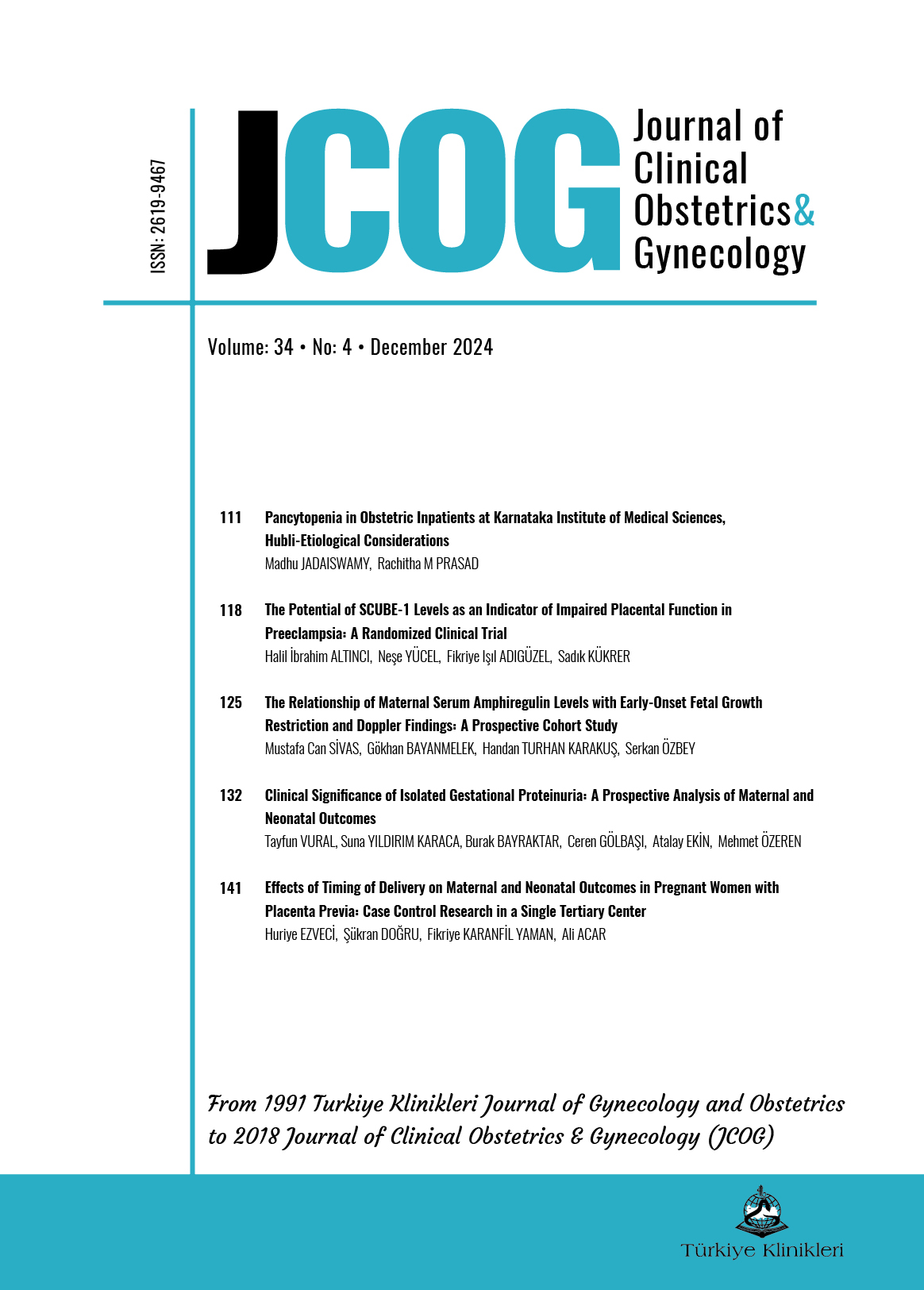Open Access
Peer Reviewed
ORIGINAL RESEARCH
1531 Viewed760 Downloaded
Pancytopenia in Obstetric Inpatients at Karnataka Institute of Medical Sciences, Hubli-Etiological Considerations
Received: 17 Nov 2023 | Received in revised form: 02 Oct 2024
Accepted: 15 Oct 2024 | Available online: 06 Nov 2024
JCOG. 2024;34(4):111-7
DOI: 10.5336/jcog.2023-100311
Article Language: EN
Article Language: EN
Copyright Ⓒ 2025 by Türkiye Klinikleri. This is an open access article under the CC BY-NC-ND license (http://creativecommons.org/licenses/by-nc-nd/4.0/)
ABSTRACT
Objective: Pancytopenia refers to the combination of anemia, leukopenia, and thrombocytopenia. Special interest has been directed to pancytopenia in obstetric population as an increasing incidence was observed in the geographical location of the population under study. Material and Methods: It's a prospective, observational study done over a period of 18 months at Karnataka Institute of Medical Sciences (KIMS), Hubli. Obstetric in-patients (antenatal and postnatal cases up to 42 days postpartum) admitted with a diagnosis of pancytopenia were included. A thorough history, clinical examination, and laboratory evaluation including serum vitamin B12 and serum folic acid levels were carried out. They were followed for feto-maternal outcome. Results: The incidence of maternal pancytopenia in our study was 0.45%. This study observed that most of the participants were vegetarian by diet with vitamin B12 deficiency followed by folate deficiency leading to pancytopenia, with majority (37.7%) hailing from Gadag district. 91.1% of the patients with pancytopenia were found to have vitamin B12 deficiency and 62.2% among them had serum vitamin B12 levels as low as 50-100 pg/mL. Most of the patients [11 (24.44%)] had serum folic acid levels between 4.1-5.0 ng/mL. Conclusion: Association of pancytopenia with pregnancy is a rare entity, yet it has increased the risk of poor maternal and fetal outcome. Proper dietary counselling and well-balanced dietary plans can prevent the micronutrients deficiency and avoid the deleterious consequences like pancytopenia.
Objective: Pancytopenia refers to the combination of anemia, leukopenia, and thrombocytopenia. Special interest has been directed to pancytopenia in obstetric population as an increasing incidence was observed in the geographical location of the population under study. Material and Methods: It's a prospective, observational study done over a period of 18 months at Karnataka Institute of Medical Sciences (KIMS), Hubli. Obstetric in-patients (antenatal and postnatal cases up to 42 days postpartum) admitted with a diagnosis of pancytopenia were included. A thorough history, clinical examination, and laboratory evaluation including serum vitamin B12 and serum folic acid levels were carried out. They were followed for feto-maternal outcome. Results: The incidence of maternal pancytopenia in our study was 0.45%. This study observed that most of the participants were vegetarian by diet with vitamin B12 deficiency followed by folate deficiency leading to pancytopenia, with majority (37.7%) hailing from Gadag district. 91.1% of the patients with pancytopenia were found to have vitamin B12 deficiency and 62.2% among them had serum vitamin B12 levels as low as 50-100 pg/mL. Most of the patients [11 (24.44%)] had serum folic acid levels between 4.1-5.0 ng/mL. Conclusion: Association of pancytopenia with pregnancy is a rare entity, yet it has increased the risk of poor maternal and fetal outcome. Proper dietary counselling and well-balanced dietary plans can prevent the micronutrients deficiency and avoid the deleterious consequences like pancytopenia.
REFERENCES:
- Mathapati S, Biradar A, Sangolli L, Gamini BS, Sridevi HS. Pregnancy with pancytopenia, an observational study. International Journal of Reproduction, Contraception, Obstetrics and Gynaecology. 2020;9(8):3134-7. [Crossref]
- Jain A, Naniwadekar M. An etiological reappraisal of pancytopenia - largest series reported to date from a single tertiary care teaching hospital. BMC Hematol. 2013 6;13(1):10. [Crossref] [PubMed] [PMC]
- Kulkarni Naveen S, Patil Appu S, Karchi SD. Study of pancytopenia in a tertiary care hospital in North Karnataka. Int J Med Res Health Sci. 2017;6(3):61-7. [Link]
- Nath J, Sheth K. A clinical study on pancytopenia in pregnancy in women of rural Haryana. J Clin Exp Immunol. 2021;6(3):333-5. [Crossref]
- Obaji SG, Al-Ismail S. Isolated folate deficiency causing profound pancytopenia in pregnancy. BMJ Case Rep. 2015;2015:bcr2014207861. [Crossref] [PubMed] [PMC]
- Van de Velde A, Van Droogenbroeck J, Tjalma W, Jorens PG, Schroyens W, Berneman Z. Folate and vitamin B(12) deficiency presenting as pancytopenia in pregnancy: a case report and review of the literature. Eur J Obstet Gynecol Reprod Biol. 2002;100(2):251-4. [Crossref] [PubMed]
- Dragusin RC, Murray JM, Mallet D, Gonzalez H, Markou GA. Pancytopenia related to malnutrition during pregnancy. Int J Gynaecol Obstet. 2015;130(1):86-7. [Crossref] [PubMed]
- Teklu S, Gebremedhin A, Meressa A, Feki B. Pancytopenia in pregnant mothers from Eastern Shoa zone of Ethiopia: a case series. Ethiop Med J. 2016;54(3):141-4. [PubMed]
- Agarwal A, Khatri N, Singh P. Pancytopenia in pregnant patients with COVID-19 infection and vitamin B12 deficiency: a case report study. Journal of Ideas in Health. 2021;4(Special 2):415-8. [Crossref]
- Issa N, Lacassin F, Camou F. First case of persistent pancytopenia associated with SARS-CoV-2 bone marrow infiltration in an immunocompromised patient. Ann Oncol. 2020;31(10):1418-9. [Crossref] [PubMed] [PMC]
MENU
POPULAR ARTICLES
MOST DOWNLOADED ARTICLES





This journal is licensed under a Creative Commons Attribution-NonCommercial-NoDerivatives 4.0 International License.










